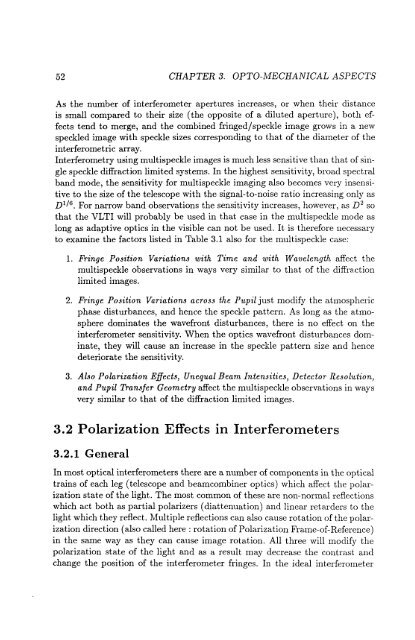The VLT Interferometer - ESO
The VLT Interferometer - ESO
The VLT Interferometer - ESO
Create successful ePaper yourself
Turn your PDF publications into a flip-book with our unique Google optimized e-Paper software.
52 CHAPTER 3. OPTO-MECHANICAL ASPECTS<br />
As the number of interferometer apertures increases, or when their distance<br />
is small compared to their size (the opposite of a diluted aperture), both effects<br />
tend to merge, and the combined fringed/speckle image grows in a new<br />
speckled image with speckle sizes corresponding to that of the diameter of the<br />
interferometric array.<br />
Interferometry using multi speckle images is much less sensitive than that of single<br />
speckle diffraction limited systems. In the highest sensitivity, broad spectral<br />
band mode, the sensitivity for multispeckle imaging also becomes very insensitive<br />
to the size of the telescope with the signal-to-noise ratio increasing only as<br />
D 1 / 6 • For narrow band observations the sensitivity increases, however, as D2 so<br />
that the <strong>VLT</strong>I will probably be used in that case in the multispeckle mode as<br />
long as adaptive optics in the visible can not be used. It is therefore necessary<br />
to examine the factors listed in Table 3.1 also for the multispeckle case:<br />
1. Fringe Position Variations with Time and with Wavelength affect the<br />
multi speckle observations in ways very similar to that of the diffraction<br />
limited images.<br />
2. Fringe Position Variations across the Pupil just modify the atmospheric<br />
phase disturbances, and hence the speckle pattern. As long as the atmosphere<br />
dominates the wavefront disturbances, there is no effect on the<br />
interferometer sensitivity. When the optics wavefront disturbances dominate,<br />
they will cause an increase in the speckle pattern size and hence<br />
deteriorate the sensitivity.<br />
3. Also Polarization Effects, Unequal Beam Intensities, Detector Resolution,<br />
and Pupil Transfer Geometry affect the multispeckle observations in ways<br />
very similar to that of the diffraction limited images.<br />
3.2 Polarization Effects in <strong>Interferometer</strong>s<br />
3.2.1 General<br />
In most optical interferometers there are a number of components in the optical<br />
trains of each leg (telescope and beamcombiner optics) which affect the polarization<br />
state of the light. <strong>The</strong> most common of these are non-normal reflections<br />
which act both as partial polarizers (diattenuation) and linear retarders to the<br />
light which they reflect. Multiple reflections can also cause rotation of the polarization<br />
direction (also called here: rotation of Polarization Frame-of-Reference)<br />
in the same way as they can cause image rotation. All three will modify the<br />
polarization state of the light and as a result may decrease the contrast and<br />
change the position of the interferometer fringes. In the ideal interferometer

















